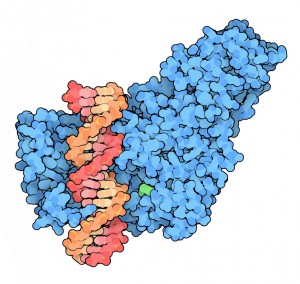Written by Dr Steven G. Gray, St James’s Hospital/Trinity College Dublin, Ireland
The first inhibitor of DNA methyltransferases (5- azacytidine) was initially synthesized in 1964 [1], and their potential as an anti-cancer agent was recognised very early on [2]. The original studies of these agents in the clinic in the 1980s used decitabine as a classical anticancer drug, with dosing at its maximum clinically tolerated dose, 1500 to 2500 mg/m(2) per course with limited success [3]. It was only when lower dosages (those that are not cytotoxic, yet cause the reactivation of epigenetically silenced silenced genes) that any significant progress was made, and after nearly 40 years 5-azacytidine (Vidaza) finally achieved FDA approval in 2004/2005 specifically for the treatment of myelodysplastic syndrome (MDS) subtypes [4]. In 2006, the FDA also approved 5-aza-2-deoxycytidine (Decitabine, Dacogen) for the treatment of patients with MDS. The data regarding low-dose regimens and the FDA approval has paved the way for refining the use of such low-dose regimens not only for haematological malignancies but potentially also for solid tumours [5].
 One of the current major issues relating to the use of these drugs particularly within the setting of low-dose regimens is that whilst low-dose therapy with agents such as Decitabine is effective for MDS and AML and can induce complete remissions (CR) [6], maintenance of remission is difficult (a) because the plasma half-life of decitabine in humans is approximately 20 minutes and (b) the dose given may not be sufficient to destroy all of the cancer stem cells present [7].
One of the current major issues relating to the use of these drugs particularly within the setting of low-dose regimens is that whilst low-dose therapy with agents such as Decitabine is effective for MDS and AML and can induce complete remissions (CR) [6], maintenance of remission is difficult (a) because the plasma half-life of decitabine in humans is approximately 20 minutes and (b) the dose given may not be sufficient to destroy all of the cancer stem cells present [7].
The potential for low-dose therapy in solid tumours is gaining traction with recent work demonstrating that transient exposure of cultured and primary epithelial tumor cells to clinically relevant nanomolar doses without causing immediate cytotoxicity, produced an antitumor “memory” response, (which also included the inhibition of subpopulations of cancer stem-like cells) [8], and additional workup both from low-dose Azacytidine based regimens in the clinic for non-small cell lung cancer (NSCLC) [9], and subsequent downstream analyses based on this data has resulted in the development of a a biomarker strategy involving monitoring upregulation of the PD-1/PD-L1 pathway by Azacytidine which has now entered into a trial to examine the potential of epigenetic therapy to sensitize patients with NSCLC to PD-1 immune checkpoint blockade [10].
The potential for the use of low-dose azacytidine regimens to induce chemosensitization has been further enhanced by the recent exciting data regarding the use of Azacytidine in a Phase I trial of diffuse large B-cell lymphoma (DLBCL). In this study, prolonged exposure to low-dose Azacytidine reprogrammed chemoresistant cells to become doxorubicin sensitive, and in a Phase I trial involving 12 newly diagnosed DLBCL patients 11/12 treated with this regimen achieved CR, with 10 remaining in remission at the median follow-up of 13 months [11].
So, while it has taken over forty years the “slowly” shifting realities for epigenetic-based therapies in the clinic using demethylating agents are in fact rapidly emerging into the limelight.
References:
[1]. Piskala A, Sorm F. (1964). Collect Czech Chem. Commun., 29: 2060-2076.
[2]. Sorm F, et al. (1964). Experientia. 20(4):202-3.
[3]. Jabbour E, et al. (2008). Cancer. 112(11):2341-51.
[4]. Kaminskas E, et al. (2005). Clin Cancer Res. 11(10):3604-8.
[5]. Baylin SB & Jones PA. (2011). Nat Rev Cancer. 11(10):726-34.
[6]. Lin J, et al., (2013). Oncol Lett. 5(4):1321-1324.
[7]. Karahoca M & Momparler RL. (2013). Clin Epigenetics. 5(1):3.
[8]. Tsai HC, et al., (2012). Cancer Cell. 21(3):430-46.
[9]. Juergens RA, et al., (2012). Cancer Discov. 1(7):598-607.
[10]. Wrangle J, et al., (2013). Oncotarget. 4(11):2067-79.
[11]. Clozel T, et al., (2013). Cancer Discov. 3(9):1002-19.
Image source: RSCB PDB
Sam Rose
Latest posts by Sam Rose (see all)
- Raising funds for genetic diseases - 23rd September 2016
- The Epigenetics and Chromatin Clinic - 9th November 2015
- Resurrecting one of the oldest genetics journals - 23rd October 2015
Comments